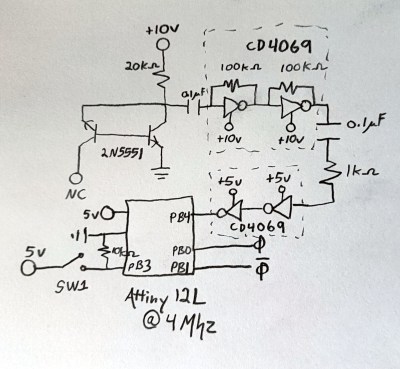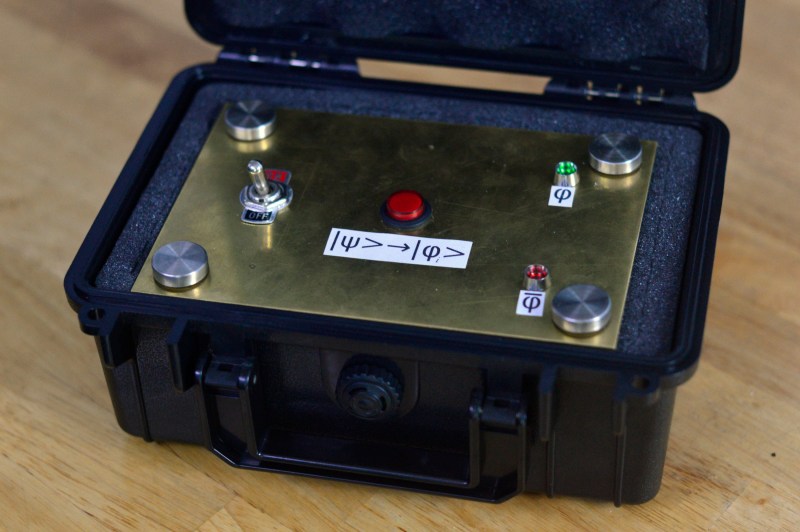While it’s true that Hackaday scribes and their families are sadly unable to compete in our contests, Hackaday alum are more than welcome to throw their hat in the ring. [Legionlabs] even made a game of it — they used only parts from the scrap heap, and even played beat the clock to build a real, science-fictiony, working thing in eight hours or less.
Okay, cool, but what does it do? Well, put simply, a rising edge on the input drives one of two outputs, lighting one of two drool-worthy flanged LEDs. Which output will [alight] is unknowable until observed, thus the Schrodinger’s aspect. In practice, the output is determined by sampling. In this case, the sampling is of the time difference between three electron-tunneling events.
 Stage one of Schrodinger’s Trigger is a pair of inputs — one variable 10-15 VDC input and 5 VDC input. Then comes the electron-tunneling event generator. [Legionlabs] is reverse-biasing a semiconductor junction (a 2N551 transistor). What does that mean? If we consider the junction as a diode and apply voltage in the wrong direction, what happens? At best, nothing; at worst, the smoke monster appears to admonish us.
Stage one of Schrodinger’s Trigger is a pair of inputs — one variable 10-15 VDC input and 5 VDC input. Then comes the electron-tunneling event generator. [Legionlabs] is reverse-biasing a semiconductor junction (a 2N551 transistor). What does that mean? If we consider the junction as a diode and apply voltage in the wrong direction, what happens? At best, nothing; at worst, the smoke monster appears to admonish us.
But with a semiconductor acting as a diode, some electrons are bound to jump across the junction. This is known as tunneling, and is a useful phenomenon as it is purely random.
Stage three consists of amplifying the signal from these rebel electrons via hex inverters. Why not op-amps? The CD4069s were cheaper and within reach. Finally, the amplified signals are sampled with an ATtiny12, and some assembly logic figures out which LED to light.
It’s nice to see an entry that leans more toward the science side of things while winning aesthetically. We dig the nice ABS enclosure, and are totally envious of [Legionlabs]’ access to flanged LEDs and those glass table top mounting point discs in the corners.
















Please tell me that no cats were killed in the making of this machine
Maybe, maybe not..
I prefer not to know.
Could this be a basis of a random number generator with a few of these in parallel?
Maybe, maybe not…
It’s easier to accumulate bits over time from a single source. I tried this, and ran some tests on 100 megabits of data. I don’t have the results handy, but they were OK. I wouldn’t use it to protect state secrets, but it didn’t have any obvious problem either.
That reverse-biased transistor is operating as a zener diode (and probably not fully into avalanche), passing maybe a microamp: trillions of electrons per second. Though maybe technically a quantum tunneling process, it is not dribbling a random electron from time to time: This is statistically a DC signal around 6 volts, with a tiny bit of very wideband gaussian noise. The fact the micro measures any time difference at all between events is more to do with the bandwidth of the amplifier and sampling process, not at all the rate at which the electrons tunnel through.
That’s correct, and I’m glad you weighed it with this! My best equipment can detect stuff around the 20MeV range, which I have used to detect individual tunneling events (decay of large nuclei). I’m certainly quite far off from being able to detect individual electrons — now that would be a spare parts bin I’d like to have!
For this device, I take a little artistic license (it is after all, a submission in a science fiction contest) and I must admit that I call “technically a quantum tunneling process” good enough. It’s a heck of a lot less artistic license than everyone else seems to take with the word ‘quantum’, so I hope I can be forgiven.
I did however put a little bit of work into my determination of “good enough” which may interest you. I had measured the signal using a scope with much higher bandwidth than my amplifier circuit. The time domain and shape remain essentially identical before and after the first amplifier stage. I did also collect and analyze 100 megabits of output from the algorithm to check for obvious fail states (I didn’t find anything damning). I had also tried with an actual zener diode, to make sure the signal I am seeing here has the same characteristics — the time domain changes (faster), but the other characteristics of the signal are essentially the same.
In the end, it’s an decent random event generator that uses a well-known noise generation technique, that itself vaguely involves a quantum process on some level. I don’t read into it any further than that, and look forward to using the device frivolously and with much drama.
(Even alums get the automod treatment, hunh?)
Fit for purpose, and done well. Enjoy the frivolity and drama!
Aww, my original comment got eaten somehow. OK, in summary that’s essentially correct and I’m glad you brought it up!
It’s a random event generator that uses a well-known noise generation circuit, that itself vaguely involves a quantum tunneling process. As this is a science fiction contest, I took the artistic license to call that “good enough”. For now, anyway.
I did spend some time characterizing a few of the things you bring up, which I hope you will find interesting. I compared the output of the two-transistor system to a zener, and the waveform is essentially the same, but occurs on a different time domain (the zener is much faster). I also tried various different transistor pairs and saw the time domain varied, but the signal was otherwise similar. I also recorded 100 megabits of output and characterized it to look for obvious issues, but didn’t find anything too scandalous.
Finally, I used a scope that has much higher bandwidth than this amplifier, and compared the signal directly coming from the transistor pair to the signal coming out from the first stage of the amplifier (before connecting it). The shape of the signal and the time domain are identical, other than it being inverted and higher amplitude.
But no, we’re not measuring individual tunneling electrons here. I’ll have to wait until retirement to have the time to build such things, so give me a couple of years, OK?
I was going to say that.. or was I?
I’ve hear reverse biasing a bipolar junction transistor base-emitter transistor junction is a Bozo-NoNo. It degrades the reverse-biased junction, and can/will lead to premature failure.
https://electronics.stackexchange.com/questions/289058/are-reverse-biased-transistors-stable
I’ll post pics when it happens for the amusement of all! It’s true that a reverse biased zener will probably last longer, but the signal I got was somewhat too fast to sample with what I had in my parts bin. I had built a separate working device using a reverse-biased zener for the purposes of comparing the waveform to the one produced by this device.
IIRC, from an ancient sci.electronics.design post or Horowitz & Hill, the NoNo is exceeding the ABSOLUTE MAXIMUM RATINGS of the BJT device. You’re suppose to reverse-bias a zener’s junction. Same with avalanche breakdown. A hot plasma is generated which must be accounted for in the physical junction implementation to prevent device damage.
The kicker is the unpredictability of failure. Avalanche rated BJT pulse generators have a reliable MTBF (mean time between failure) as do many components.
Those “flanged LEDs” are nothing more than standard LEDs in panel mount holders that have been (and still are) standard parts for decades.
That’s correct, they are standard parts. I did not mean to imply otherwise. This does not diminish my appreciation for them.
Alum?
Alumnus?
Reader?
Subscriber?
Yeah, I don’t know either. I just wanted to share a cool toy I built, years after an old April fools article left me with an unresolved item on my to-do list.
Feelons,is it a charged particle or not?
It suddenly dawned on me that it is “unknowable” whether the circuit is broke until the smoke is observed. It might be accompanied by a faint meow…